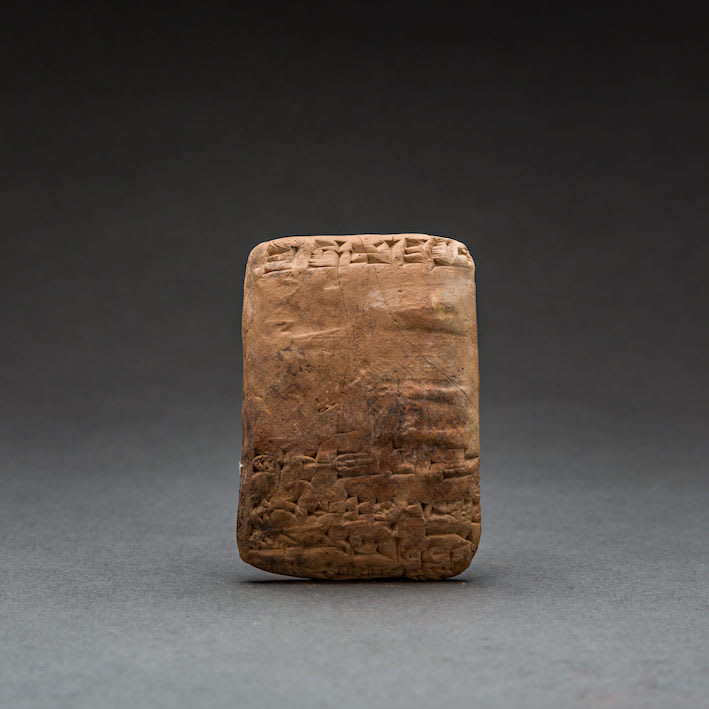Akkadian Cuneiform Tablet, 2026 BCE
7 x 4.9 cm
2 3/4 x 1 7/8 in
2 3/4 x 1 7/8 in
AM.0203
Cuneiform is one of the earliest known forms of written expression. First appearing in the 4th millennium BC in what is now Iraq, it was dubbed cuneiform (‘wedge-shaped’) because of...
Cuneiform is one of the earliest known forms of written expression. First appearing in the 4th millennium BC in what is now Iraq, it was dubbed cuneiform (‘wedge-shaped’) because of the distinctive wedge form of the letters, created by pressing a reed stylus into wet clay. Early Sumerian writings were essentially pictograms, which became simplified in the early and mid 3rd millennium BC to a series of strokes, along with a commensurate reduction in the number of discrete signs used (from c.1500 to 600). The script system had a very long life and was used by the Sumerians as well as numerous later groups – notably the Assyrians, Elamites, Akkadians and Hittites – for around three thousand years. Certain signs and phonetic standards live on in modern languages of the Middle and Far East, but the writing system is essentially extinct. It was therefore cause for great excitement when the ‘code’ of ancient cuneiform was cracked by a group of English, French and German Assyriologists and philologists in the mid 19th century AD. This opened up a vital source of information about these ancient groups that could not have been obtained in any other way.
Cuneiform was used on monuments dedicated to heroic – and usually royal – individuals, but perhaps its most important function was that of record keeping. The palace-based society at Ur and other large urban centres was accompanied by a remarkably complex and multifaceted bureaucracy, which was run by professional administrators and a priestly class, all of whom were answerable to central court control. Most of what we know about the way the culture was run and administered comes from cuneiform tablets, which record the everyday running of the temple and palace complexes in minute detail, as in the present case. The Barakat Gallery has secured the services of Professor Lambert (University of Birmingham), a renowned expert in the decipherment and translation of cuneiform, to examine and process the information on these tablets. The following is a transcription of his analysis of this tablet:
‘A legal document from the period of the Third Dynasty of Ur, dated to the 3rd year of Ibbi-Sin, last king of the dynasty, c. 2026 B.C. The hand is large but a little clumsy, and the tablet has been rolled with the scribe’s cylinder seal, but nowhere can the seal inscriptions be read, though remains of the art-work are visible on the reverse: a seated deity (probably the divine king) and two-facing standing figures. There is one loss of surface in the middle of the obverse, and squeezed signs elsewhere, which make reading difficult. However, it is a rare kind of tablet since almost all documents of this period are in Sumerian, not Akkadian.
Translation:
286……10……of Ashgi [a god] Manager: Ashgi-……To the passing of the month Festival magnificent he…..ed and swore by the king: ‘If I have not finished, may they kill them!’ Month: Kirsi-ak. Year: Ibbi-Sin, king of Ur, destroyed Simurrum.
Simurrum was a small state not certainly located, but somewhere in central Mesopotamia.’
Cuneiform was used on monuments dedicated to heroic – and usually royal – individuals, but perhaps its most important function was that of record keeping. The palace-based society at Ur and other large urban centres was accompanied by a remarkably complex and multifaceted bureaucracy, which was run by professional administrators and a priestly class, all of whom were answerable to central court control. Most of what we know about the way the culture was run and administered comes from cuneiform tablets, which record the everyday running of the temple and palace complexes in minute detail, as in the present case. The Barakat Gallery has secured the services of Professor Lambert (University of Birmingham), a renowned expert in the decipherment and translation of cuneiform, to examine and process the information on these tablets. The following is a transcription of his analysis of this tablet:
‘A legal document from the period of the Third Dynasty of Ur, dated to the 3rd year of Ibbi-Sin, last king of the dynasty, c. 2026 B.C. The hand is large but a little clumsy, and the tablet has been rolled with the scribe’s cylinder seal, but nowhere can the seal inscriptions be read, though remains of the art-work are visible on the reverse: a seated deity (probably the divine king) and two-facing standing figures. There is one loss of surface in the middle of the obverse, and squeezed signs elsewhere, which make reading difficult. However, it is a rare kind of tablet since almost all documents of this period are in Sumerian, not Akkadian.
Translation:
286……10……of Ashgi [a god] Manager: Ashgi-……To the passing of the month Festival magnificent he…..ed and swore by the king: ‘If I have not finished, may they kill them!’ Month: Kirsi-ak. Year: Ibbi-Sin, king of Ur, destroyed Simurrum.
Simurrum was a small state not certainly located, but somewhere in central Mesopotamia.’



